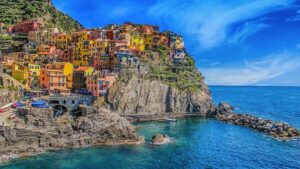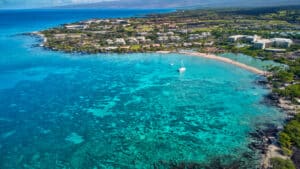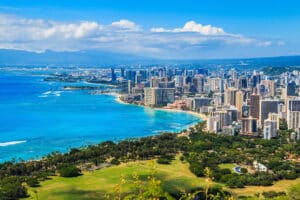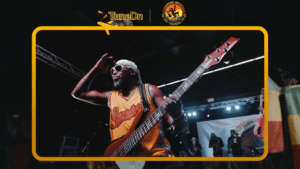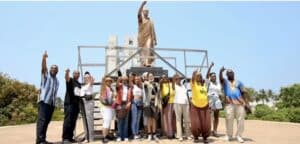
Black in Hawaii: revisiting paradise
IQ
- 4 Min Read
In order to offer transparency into how our stories are produced and to teach our readers about the importance of media literacy online, the editorial team provides a quick self-rating of the integrity of the articles and the facts presented against the following IQ metrics.
- Published on November 23, 2022
- Last Updated February 1, 2023
There is a breadth of Black history on the Hawai’ian islands. Learn about the origins of Pacific islanders and their ties to Africa here.
My earliest childhood memories are of endless days playing on the beach, eating too many of the ripe mangoes that grew on trees near our house and practicing the intricate hand stories of the hula in dance class — some of which I still use on the dance floor, much to the chagrin of my partner. There was a gorgeous feral peacock, mean as hell, strutting the yard out back on Fort Shafter, the army base on Oahu where my family lived and my father served. It was 1964, and my life couldn’t have been more idyllic.
On the mainland, the Civil Rights Movement, race riots and news of the Vietnam War convulsed the country. But we were thousands of miles from the mainland, and in Honolulu, my reality was entirely different from that of my cousins’ in Oakland, Alabama and D.C.
I thought of myself as Hawai’ian. No one told me differently. I passably spoke common phrases in the language and aloha nui loa (love, so much love) infused my daily life. At such a young age, I didn’t conceive of myself as Black — that wouldn’t happen until we returned to the mainland where the racial animus that simmered, boiled and could not be ignored erupted in our living rooms and on the streets.
But, no matter how I felt, I wasn’t Hawai’ian. I was Black in Hawai’i. There’s a difference. In Hawai’i, there are Black people whose roots plunge hundreds of years deep into the volcanic soil and white sands of the islands. The indigenous people were black-skinned Polynesians. Even though they were never enslaved in the same way as mainland African Americans, white supremacy came for them, too.
Looking at photos of Hawaiian royalty (all of the Kings Kamehameha through Queen Lili’uokalani) and of other Polynesians, Melanesians, Micronesians and the indigenous people of most islands is to seepeople of African descent.
Curious about Black experiences on Pacific islands, I spoke with Honolulu-based linguist and cultural worker Dr. Akiemi Glenn, founder and executive director of the community-based Pōpolo Project, who has done deep work on the subject. A small medicinal plant that produces purplish-black berries, Pōpolo is found throughout the Pacific islands and around the world. It has been associated, in a negative way, with Black people. Glenn is reclaiming the positive attributes of the plant and connecting it to the contributions of Black people in Polynesian culture.
“We all know that humanity originated on the African continent,” Glenn said. “And when we start to look at population movements out of Africa, we see a lot of those things that we identify as African features, or phenotypes, all around the world, especially in the tropical world.” Indigenous populations with dark skin and curly hair are rooted in South Asia, Australia, Southeast Asia, and throughout the Pacific. “Especially for Black Americans, when they arrive in Hawai’i, there is a sense of kinship based on the similarities with indigenous Hawai’ians.”
There is more than skin color that connects us, though. While Hawai’ians did not experience enslavement, white supremacy still affected the island kingdom. Delving into 18th-century Hawai’ian history, there’s a familiar pattern. White people, or haoles as they were termed by local communities, “discovered” the islands and colonized them, appropriating the culture and decimating the population.
Diseases brought by white sailors eventually killed more than 90% of the indigenous population. Most of the rest intermarried with successive waves of Chinese, Filipino, Korean, Portuguese and African American laborers who were brought in by sugar plantation owners. In the mid-1800s, 97% of the islands’ population was indigenous Hawaiians. By 1923, the indigenous population had declined to 16%, and the majority of Hawai’i’s population was Japanese. Today, there are estimated to be only about 5,000 pure-blood Hawai’ians in the world.
The Hawai’ian kingdom was an internationally recognized sovereign nation with trade agreements across the globe and one of the most literate populations in the world, Glenn explained. In 1893, rogue United States marines, led by U.S. businessmen, illegally overthrew the government of Queen Lili’uokalani, a dark-skinned woman who reminds me of my Big Mama.
“There is a long history of white supremacy here in Hawai’i that is related to the overthrow of Lili’uokalani’s government,” Glenn said. “That is how Hawai’i was forced to become part of the United States. We can’t talk about that without talking about anti-Black racism in the ways that Hawaiians and other indigenous people in our region are categorized as Black, for the purposes of white supremacy, to render them illegitimate in their positions of power, or even just having control over their lands.”
My friend Keito St. James identifies as both Black and Hawai’ian. When we met at the University of Texas at Austin, he was producing and performing Polynesian cultural events with his Maui-based touring company Tropical Events. Decades later, he still is.
St. James explains that Black Hawai’ans simply blended in as an integral part of the culture. “I didn’t walk around going ‘I’m a Black American mixed with Hawai’ian,’” he explained. “I blended into the community with no problem.” He defined the essential nature of being Black in Hawai’i: “On the mainland, any percentage of Black made you Black, but in Hawaii, any percentage of Hawai’ian made you Hawai’ian, period.”
K. Anoa Monsho is a creative writer, journalist, multi-media storyteller, director, and editor with a strong interest in travel, Black health and wellness, and cultural arts. She believes in the life-giving, life-healing power of sharing true stories and that travel begins in the imagination.
This story was originally published November 22, 2022 9:00 AM.

